Exploring Elevation: Progressive Bodyweight Resistance
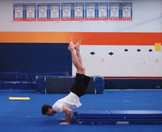
This is Part 1 in a series of articles that will cov¬er how taking advantage of various mechanical principles can provide incremental resistance for bodyweight exercises. The simplest way is to add weight to your body in the form of a vest, hip belt, ankle weights, dip belt, etc. This is pretty obvious stuff, so I will skip it and move into more interesting territory, specifically how gymnasts approach this problem. If you told a weightlift¬er that you could get super strong with a single weight, he would kindly explain to you the Law of Adaptation. It states that a stimulus must in¬crease in strength over time in order to contin¬ue the promotion of adaptation in an organism. And, of course, having a barbell is the only way to do this! However, a few clever organisms have managed to attack this problem from multiple di¬rections and have in the process discovered ath¬letic movements that promote many physical ad¬aptations beyond strength. These are not smoke and mirror tricks either. The level of difficulty in these exercises actually does increase as a result of observable phenomena.
The first principle we will look at is elevation. By manipulating the elevation of your body, or parts of your body, you can make many exercises more or less difficult. This works particularly well on horizontal exercises such as pushups. Our plat¬form for exploring this principle is the Stomach Roll to Handstand. In this exercise, you start on the ground in a prone position, roll forward onto your stomach, then press up to a handstand. It has the largest range of motion of any pressing movement that I have ever seen. It covers both the horizontal and verti¬cal planes of motion. It also develops body control, balance, timing, coor¬dination and just plain looks cool.
Since this exercise is very hard for most people, we need a progression that will enable anyone with a hand¬stand pushup to attempt it and then progressively increase the resistance to the point where he or she can ac¬tually complete the skill on the floor. Elevation is the best way to do this. All you will need for this is some¬thing that you can use to elevate your torso. Panel mats work really well, but a stack of books with something soft on top will work fine as well. When you are looking for your appa¬ratus, just make sure that it is height-adjustable and soft enough that you don’t “smash your sausage.”
In the beginning, you will probably want a stack between 1- and 2-feet high. To start, lie face down with your belly button lined up with the edge of the stack. Place your hands on the ground at the same width you use for handstand pushups. Arch your back as much as you need to in order to straighten out your arms. From here, quickly rock for¬ward onto your stomach and bend your arms. As your center of gravity shifts over your hands, press up to a handstand and straighten out your body. If you fall short, lower down onto one knee and then the other. If you fall forward, do a forward roll. This is a good place to mention that you should be comfortable doing a handstand-forward roll on whatever surface is in front of you. Obviously, keep this area free of fragile objects, pets, your mother-in-law, or anything else that could injure you.
After a few attempts, if you are not able to get to a hand¬stand, then you will need to make your stack high¬er. If you have success¬fully completed it, then lower your stack by just a few inches and then make another attempt. Continue to lower the stack until you reach the ground. Those last few inches above the ground are always the hardest.
As for a training program, this is really up to you. I like to do about four or five sets with increasing difficulty and then two more at an easier level. Each set is just one or two reps. If I struggle with form, I will do another rep. If it goes smoothly on the first attempt, I move on. I always keep track of how far I get. Right now, the full stack (six panels) is pretty easy, so I will do one rep as a warm-up. I then skip a panel and go straight to four. I then proceed downward from there. A sample workout might start at six panels and then go: 4,3,2,1,0,0,2,2. (Zero is on floor without any panels)
Next month I will intro¬duce a new principle and apply it to a different exercise. Definitely get started on the Stomach Roll to Handstand, as we will come back to it later with a few different vari¬ations. Have fun!
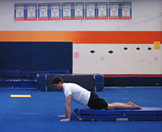
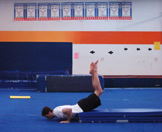
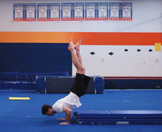
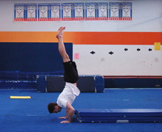
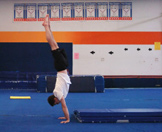
The first principle we will look at is elevation. By manipulating the elevation of your body, or parts of your body, you can make many exercises more or less difficult. This works particularly well on horizontal exercises such as pushups. Our plat¬form for exploring this principle is the Stomach Roll to Handstand. In this exercise, you start on the ground in a prone position, roll forward onto your stomach, then press up to a handstand. It has the largest range of motion of any pressing movement that I have ever seen. It covers both the horizontal and verti¬cal planes of motion. It also develops body control, balance, timing, coor¬dination and just plain looks cool.
Since this exercise is very hard for most people, we need a progression that will enable anyone with a hand¬stand pushup to attempt it and then progressively increase the resistance to the point where he or she can ac¬tually complete the skill on the floor. Elevation is the best way to do this. All you will need for this is some¬thing that you can use to elevate your torso. Panel mats work really well, but a stack of books with something soft on top will work fine as well. When you are looking for your appa¬ratus, just make sure that it is height-adjustable and soft enough that you don’t “smash your sausage.”
In the beginning, you will probably want a stack between 1- and 2-feet high. To start, lie face down with your belly button lined up with the edge of the stack. Place your hands on the ground at the same width you use for handstand pushups. Arch your back as much as you need to in order to straighten out your arms. From here, quickly rock for¬ward onto your stomach and bend your arms. As your center of gravity shifts over your hands, press up to a handstand and straighten out your body. If you fall short, lower down onto one knee and then the other. If you fall forward, do a forward roll. This is a good place to mention that you should be comfortable doing a handstand-forward roll on whatever surface is in front of you. Obviously, keep this area free of fragile objects, pets, your mother-in-law, or anything else that could injure you.
After a few attempts, if you are not able to get to a hand¬stand, then you will need to make your stack high¬er. If you have success¬fully completed it, then lower your stack by just a few inches and then make another attempt. Continue to lower the stack until you reach the ground. Those last few inches above the ground are always the hardest.
As for a training program, this is really up to you. I like to do about four or five sets with increasing difficulty and then two more at an easier level. Each set is just one or two reps. If I struggle with form, I will do another rep. If it goes smoothly on the first attempt, I move on. I always keep track of how far I get. Right now, the full stack (six panels) is pretty easy, so I will do one rep as a warm-up. I then skip a panel and go straight to four. I then proceed downward from there. A sample workout might start at six panels and then go: 4,3,2,1,0,0,2,2. (Zero is on floor without any panels)
Next month I will intro¬duce a new principle and apply it to a different exercise. Definitely get started on the Stomach Roll to Handstand, as we will come back to it later with a few different vari¬ations. Have fun!





|
Tyler Hass is the designer of Elite Rings. His goal is to spread gymnastics training into the broader fitness community. His website is www.ringtraining.com. |
Search Articles
Article Categories
Sort by Author
Sort by Issue & Date
Article Categories
Sort by Author
Sort by Issue & Date

